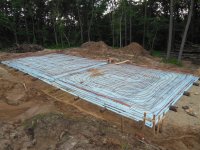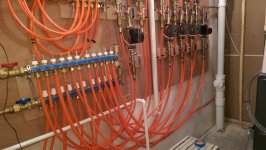Been reading along and have some pointers/info from my experience the past 5 winters in my shop and 4 in the house, heated the same as yours - via a tankless heater. Sorry about the length but I have some significant learnings...
The first winter was pretty great (shop only). Towards the end of the season I started to hear the heater buzzing/vibrating when it was running and it got pretty bad. In my research I learned this was cavitation - where the water is actually boiling in spots. This is not good for the heater at all. I called the place that I got the supplies from and he suggested that the regular 15 psi was insufficient for a tankless heater and to take it up to 25-30 psi. He was right (sort of - I'll get to that next). Now to take the system up in pressure, you first need to take the pressure off the air bladder expansion tank, and pump it up to the higher pressure you are targeting. Then top off the system and flush the air from the lines, then pressurize.
Anti-freeze. I did not start with anti freeze, just water. I started to get concerned that if the heat went down or something happened, the system might freeze up. That would be super bad. So I calculated the system total volume and then pumped in enough radiant system anti freeze to make up approx half of that while pumping out water. Shooting for the 50/50 ratio. This was when the cavitation problem really became pronounced and I made the call I described above.
Yrs 2-3-4 saw some cavitation occurring but it was much milder than before. I also ran into problems with the little filter plugging up and choking flow so I had to take it down to clean that out a few times over the heating seasons. Every time you do this, it is the same old top off, flush air, repressurize routine. That gets old. Then something else happened in year 4 that woke me up. A little background is needed: I have radiant in the shop and house, and a tankless heater for the house domestic HW. The shop unit is 95% efficient but the house ones are 97% and the 2 in the house are identical to each other (1 on radiant, 1 on DHW). The DHW started leaking and it turned out the be the heat exchanger. Well within warranty but I was not pleased and puzzled. The manufacturer (Takagi for all these) had good support and sent me a heat exchanger but I had to install it. That was VERY painful as everything has to come out to swap that, plus a lot of wiring. Thank gawd for their detailed instructions with photos. So he sent it as a "goodwill" gesture at the start, and that seemed odd. He wanted me to send back photos of the underside of the HX after I got it out. There were blackened areas on it and he said that was from hard water and that it did not fall under warranty, but they would allow me this one time freebie, but not again. So the water... When we moved in, i had not yet put a softener in thinking I would get to it soon. Well within 2-3 months, shower heads and valves were plugging up with hard water deposits. Got a testing kit and my hardness came in around 26 grains. Well I got a softener in shortly after and so we had run hard water for only about 4 months total. That was enough to kill this heat exchanger a couple years later. Hmmmm.... the other 2 heaters for house and shop radiant were filled with hard water...
So the house radiant had started making cavitation noises also, so before the start of this heating season, I did a descale on the 2 radiant heaters. AHA! Now all of a sudden everything is nice and quiet. So i believe the cavitation is a combination of the scale build up and the initial low pressure.
So the lessons from this are 1. NO hard water! Or you need to descale from time to time. 2. 25-30 psi is a much better pressure for a radiant system on a tankless vs the standard radiant pressure of 15 psi.
I find it works great for heat. Always nice and comfortable. The floors are never really very warm, except in some spots, like near the manifold. The thing I really notice with it is that the floors don't feel warm, but they never feel cold in bare feet. If I had the floors warm enough to feel significantly warm to the touch, it would be a sauna in here, as the house is well sealed and insulated. The only real downside is that drilling into the shop floor to mount things is pretty much a no-no. I tried to scope it all out with an IR camera one time, but could not tell well enough where the lines were.




